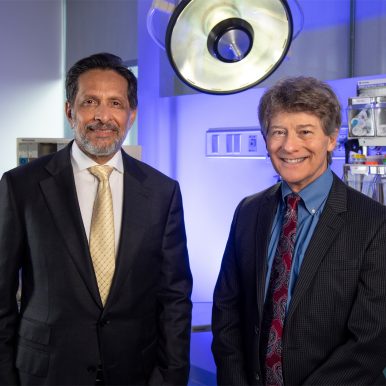Gift of a lifetime
Doctor’s $104 million VCU donation aids liver research
Kira Jenkins //May 29, 2022//
Gift of a lifetime
Doctor’s $104 million VCU donation aids liver research
Kira Jenkins //May 29, 2022//
For Dr. Todd Stravitz, February was an opportune time to make the largest gift in the history of Virginia Commonwealth University — a $104 million donation to support liver research.
The retired medical director of VCU Health‘s Hume-Lee Transplant Center, Stravitz is an heir to the Boar’s Head Provisions Co. Inc. fortune. His mother, Barbara Brunckhorst, died in late 2020. Her father, Frank Brunckhorst, founded the delicatessen products company, which is now based in Florida, in 1905.
“One of the things that she and I discussed when she knew that she was dying of this brain cancer is opening up the [Brunckhorst] Foundation to donate to medical causes,” Stravitz explains. “And since I knew nothing about neurosurgery or brain cancer, but I knew quite a bit about liver disease, that was really sort of what pushed me into it.”
A Virginia native who lives in Richmond, Stravitz is a co-executor of his mother’s estate. Her shares of the deli meats company are the subject of a still-pending court dispute between two branches of the family. Boar’s Head brings in approximately $1 billion in annual revenue.

Although Barbara Brunckhorst’s philanthropic interests primarily lay in environmental causes, Stravitz’s donation will go toward establishing the Stravitz-Sanyal Institute for Liver Disease and Metabolic Health, which VCU announced in December 2021, as well as establishing two endowed chairs at VCU’s School of Medicine. One chairmanship is named for Stravitz’s former colleague, Dr. Arun J. Sanyal, a gastroenterologist and liver specialist who has known Stravitz for more than three decades.
“He was one of our fellows going through specialized training,” Sanyal explains. “I actually taught him how to do a liver biopsy. But I’ll tell you, the thing that always struck me was his sincerity … and how important it was for him to put the patient first and to go the extra mile for each and every patient. Even when he was a researcher, he was just very thoughtful and very methodical.”
Sanyal will be director of the new institute, which will align and expand VCU Health’s existing liver disease departments that are spread among the School of Medicine’s internal medicine department, the transplant center, Massey Cancer Center and the Pauley Heart Center.
Currently a professor in the medical school specializing in transplant hepatology, Stravitz built his expertise in acute liver failure, which can cause a patient to bleed to death.
Liver disease is common in the United States — affecting about one in 10 people — but does not have a cure, other than liver transplant, Stravitz notes.
Stravitz’s patients at VCU, where he started as a fellow in 1990, ranged from a 4-year-old to people in their 80s. Many were memorable, Stravitz says, but he was most struck by those he met at New York City’s Bellevue Hospital, where he interned in the mid-1980s during the height of the HIV and AIDS epidemic.
Most liver patients he saw there were young “and often didn’t have any medical care,” Stravitz says. “Some of them were brought in from the street. That was what kind of shocked me into realizing that all of them were going to die, back in the ’80s. We had no treatment for these folks.”
The combination of a challenging disease and its surrounding social issues led to his specializing in liver disease and heading to VCU, which has been a cutting-edge leader in liver research since the 1970s and was one of the first three hospitals to transplant the liver of a living donor in 1998.
His interest in attending medical school, however, started even earlier. “My mother was a determined, intelligent, frustrated doctor herself,” Stravitz says. “She would have gone to medical school 60, 70 years ago, but my grandfather wanted her to go into the family business, which she did for a little bit, and then had a family.”
Brunckhorst gave her son an anatomy book when he was about 3 or 4 years old, he recalls, and “that’s where I got my interest in science and in human anatomy.” After graduating in 1982 from William & Mary, Stravitz earned his medical degree from New York University’s Grossman School of Medicine.
Stravitz says that scientists started studying liver disease only in the 1970s “and really caught traction from the ’90s on up, but research in human liver diseases was really relatively modern. The science [has] accelerated so tremendously around molecular biology and genetics, especially within the last 10 years.”
That makes it an optimal time “to seize the science by the horns and direct it to VCU for this project and for this gift,” Stravitz says. He’s particularly excited about gene therapy as an alternative to transplants, which often entail long waits for patients.
With the donation, VCU will be able to recruit 30 to 60 more researchers, faculty and staff members, as well as establish new degree programs at the graduate, postgraduate and postdoctoral levels.
Over the past decades, “we relied heavily on the National Institutes of Health … but NIH funding is very focused,” Stravitz says. “It doesn’t allow exploration so much. It’s a finite grant. You have three to five years to show what you have done with their money, and if you’ve not been productive and published, you might not get your next grant. That’s a lot to be looking over your shoulder all the time.”
With Stravitz’s gift, researchers and physicians will be able to focus on their work, rather than worrying about where the next grant will come from, he says. “I’m hoping that VCU, under Dr. Sanyal’s direction, can grab it and run with it, and explore things that haven’t been explored before.”
P
















